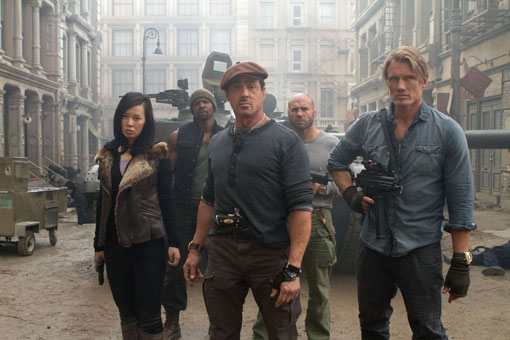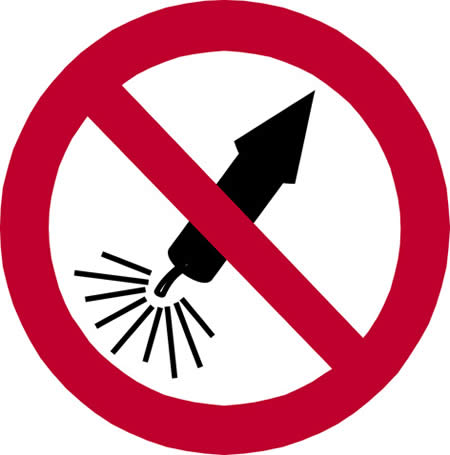The one-named Seattle critic known as Vern has this to say about The Expendables 2 and the state of action movies in general. -Eds.
Remember how action movies used to be? The good old-fashioned American (but often European-accented) ones from the ‘80s and ‘90s, the type paid tribute to (but not necessarily re-created) in the Expendables movies? No offense to your Iron Men and your Jason Bournes, but I miss movies like Die Hard, First Blood, Commando, Predator, and their more martial-arts-oriented cousins Bloodsport and Out for Justice. These were lowbrow, often low budget, their action focused on stunt work and fight choreography. Their stakes were pretty personal: rescuing a hostage, avenging a death, blowing up that alien that’s been skinning guys out in the jungles of Val Verde. Their stars were chosen more for screen presence (and sometimes fighting skill) than for traditional ideas of acting talent. And they were a bonding ritual for brothers and buddies and dads taking the kids to R-rated movies to seem cooler than mom.
Well, things change. The audience that once flocked to Lethal Weapon sequels and Dolph Lundgren vehicles has just spent another summer feeding on a diet of super hero and fantasy cinema full of cartoonish PG-13 action largely created in computers. The digital effects that were so impressive in Terminator 2: Judgment Day have evolved and left behind that same movie’s timeless truck, motorcycle and helicopter stunts. At the time T2 seemed bombastic and excessive, now its emphasis on characters and storytelling impact seems quaint. Yes, there was a joy in trying to blow up more shit than had ever been blown up before, but there was a story rhythm to it, there was a build, a sense of climax. There was editing and camera placement that allowed you to understand exactly what shit was blowing up, why and where it was blowing up, who was getting blown up by it.
Today even the straight action movies are drastically different because of a change in the language of cinema. Traditionally, in the best action scenes, we are swept into the movement and dragged along by the speed, but we also understand what we’re looking at. Think of Bruce Willis leaping off the building with a firehose tied around his waist, Steven Seagal bluntly subduing a bunch of thugs in an alley even though they’re the ones with the bat, Arnold Schwarzenegger hurtling through the air as the Predator’s ship self-destructs. These scenes depict destructive acts, but they celebrate the grace of trained bodies in actual motion. Jackie Chan’s fight scenes are often compared to dance numbers, John Woo’s shootouts to ballets.
These days action scenes are more like tripping and rolling down a hill. Since the mid-‘90s, coherence has become less and less of a priority. Simon West and Michael Bay popularized shorter cuts, more angles, often shot close up, without establishing important visual information like where the characters are in relation to each other or which direction they’re moving. More recently the popularity of the Bourne sequels directed by Paul Greengrass unleashed the menace of the “shakycam”–chases and fights shot messily on deliberately wobbly handheld cameras to give the impression of documentary realism–even though real footage shot by war journalists is often less messy.
Greengrass can sometimes make the style decipherable by ensuring that important visual cues (faces, fronts of vehicles) do make it into the frame, but his imitators are not always as careful. Even Jason Statham, today’s only big screen brand name action specialist, has been swept up in the close-up shaky style that has dominated since around 2005. Note the drop in fight-coherence between Transporters 2 and 3. Imagine a Gene Kelly dance sequence or the “Thriller” video shot in this style. You’d have no idea if Kelly could really tap or which one of those zombies was Michael Jackson. Or wait—are those zombies? We never get a good look.
As these styles became popular among directors and tolerated by audiences, we moved into what I call the Post-Action era. Movies like Salt, Taken, Quantum of Solace, Gamer, The Grey, and Warrior have the kinds of plots that used to be written to string together fights and chases, but the action is so muddled and incoherent it might as well be left out.
I liked all but one of these movies on some level, but they could be vastly improved with action scenes that are well planned out and properly covered. Warrior is a satisfyingly formulaic sports drama with three great lead performances, but it revolves entirely around a mixed-martial-arts tournament where very little fighting is clearly visible on screen. There are shots seemingly designed to make you feel like you’re in the crowd with a tall dude in front of you and you can’t see anything through that goddamn cage. Then it cuts to the facial expressions of people watching a TV, enjoying a better view than yours. They never did that shit in Kickboxer!
Even the attempted genre-revival The Expendables is disappointingly Post-Action. A fight between Lundgren and Jet Li barely registers their fighting styles or 11” height difference. Filming a tussle with Steve Austin, Stallone was injured so seriously he had to have a metal plate put in his neck, but you mostly see the back of their heads as they roll around in the dark swinging their fists. The fake fight was more dangerous on set than it seems on screen. (Part 2 is less shaky, but still puts Jet Li in bulky clothes and shoots him from waist to eyebrow.)
I never thought it would come to this, but clear action has been left to arthouse directors. Steven Soderbergh’s Haywire showcases some of the most exhilarating fights of recent years by combining the “realistic” MMA-inspired fighting preferred by Post-Action directors with the long takes and unobstructed shots they fear. (I think he used a new technology called “tripods.”) Joe Wright’s Hanna has an Eric-Bana-vs.-four-guys fight scene that’s done in one uninterrupted steadicam shot, showing the whole fight instead of implying it through editing. Nicolas Winding Refn’s Drive, despite being sued by that lady for not being enough like Fast Five, punctuates its slow burn story with superb car chases. (Fast Five, come to think of it, also has great action and stunts, but good ol’ R-rated blood would’ve really helped its Diesel-vs.-Rock fist fight.)
But most of the good stuff these days is hidden outside of the mainstream in direct-to-video movies. It’s a refuge not just for aging icons like Seagal, Lundgren and Jean-Claude Van Damme, but for a talented new wave that includes Austin (Damage), Scott Adkins (Undisputed II-III), Michael Jai White (Blood and Bone), and how-the-hell-hasn’t-a-studio-thrown-money-at-this-guy-yet directors Isaac Florentine and John Hyams. I maintain that Hyams’ 2009 Universal Soldier: Regeneration is a more thrilling action experience than 95% of what studios have released in theaters in several years. The opening hurls us into an intense abduction-car-chase-shootout-helicopter-escape while always keeping the vehicles and victims clearly in the center of the frame, making it a DTV classic before we’ve even seen Van Damme or any super-powered fighting.
Like Seagal in Hard to Kill, old school action has emerged from its coma and is re-training itself. Soon it will sit on top of a small hill, it will hear the call of an eagle, and it will be ready for its revenge. But we might have to convince the dads that used to take their kids to Marked for Death that now the thing to do is buy them the fifth Universal Soldier.
9Vern is the author of Seagology: A Study of the Ass-Kicking Films of Steven Seagal and Yippee-Ki-Yay, Moviegoer: Writings on Bruce Willis, Bad-Ass Cinema, and Other Important Topics. His reviews can be found at outlawvern.com.)








